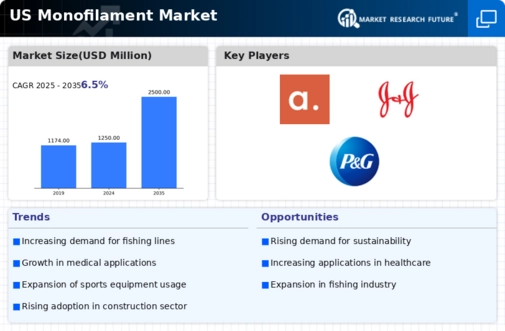The monofilament market exhibits a dynamic competitive landscape characterized by innovation and strategic partnerships. Key players such as DuPont (US), BASF (DE), and Honeywell (US) are actively shaping the market through their distinct operational focuses. DuPont (US) emphasizes sustainability and advanced materials, aiming to enhance product performance while reducing environmental impact. BASF (DE) leverages its extensive research capabilities to innovate in high-performance monofilaments, particularly for industrial applications. Meanwhile, Honeywell (US) is concentrating on digital transformation, integrating smart technologies into its manufacturing processes to improve efficiency and product quality. Collectively, these strategies foster a competitive environment that prioritizes innovation and sustainability, driving growth in the sector.
In terms of business tactics, companies are increasingly localizing manufacturing to enhance supply chain resilience and reduce lead times. This approach appears to be a response to the growing demand for customized solutions and rapid delivery. The market structure is moderately fragmented, with several players vying for market share. However, the influence of major companies like DuPont (US) and BASF (DE) is substantial, as they set benchmarks for quality and innovation that smaller firms strive to meet.
In October 2025, DuPont (US) announced a partnership with a leading renewable energy firm to develop bio-based monofilament products. This strategic move is likely to position DuPont (US) at the forefront of sustainable materials, appealing to environmentally conscious consumers and industries. The collaboration underscores the increasing importance of sustainability in product development, potentially reshaping consumer preferences in the market.
In September 2025, BASF (DE) launched a new line of high-strength monofilaments designed for the automotive sector. This initiative reflects BASF's commitment to innovation and its strategic focus on high-performance applications. By catering to the automotive industry's demand for lightweight and durable materials, BASF (DE) is likely to enhance its competitive edge and capture a larger market share.
In August 2025, Honeywell (US) unveiled a new digital platform aimed at optimizing the production of monofilaments through AI-driven analytics. This platform is expected to streamline operations and reduce costs, thereby enhancing Honeywell's market position. The integration of AI into manufacturing processes signifies a broader trend towards digitalization in the industry, which could redefine operational efficiencies and product quality.
As of November 2025, the competitive trends in the monofilament market are increasingly defined by digitalization, sustainability, and technological integration. Strategic alliances are becoming more prevalent, as companies recognize the value of collaboration in driving innovation. The shift from price-based competition to a focus on technology, supply chain reliability, and product differentiation is evident. Moving forward, companies that prioritize innovation and sustainable practices are likely to emerge as leaders in this evolving landscape.














Leave a Comment